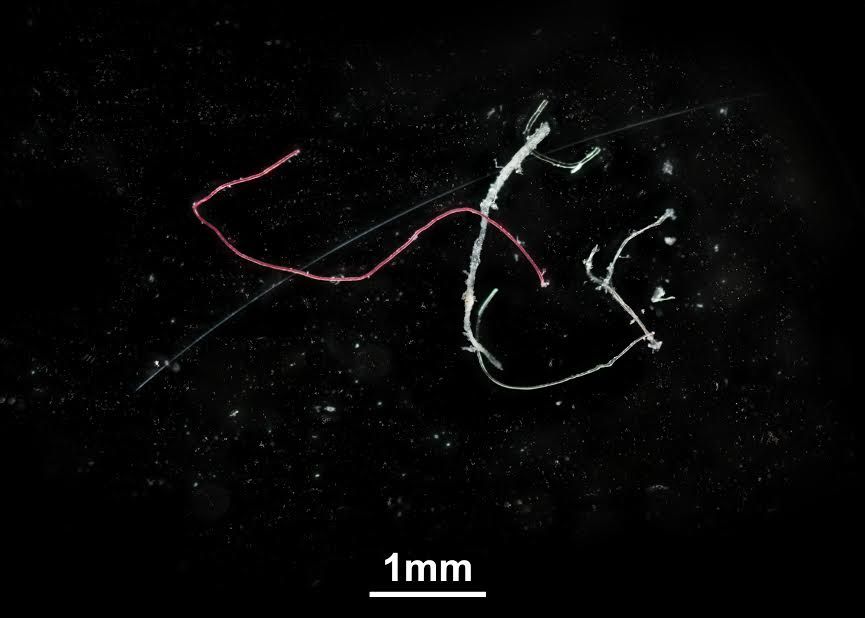
Marine biologist Lucy Woodall studies several strange and wonderful organisms that live in the ocean, like seahorses and microscopic worms called nematodes. While studying the latter, she obtained some sediment from a very deep part of the southwest Indian Ocean and examined it under a microscope.
Woodall saw some miniature worms—but also saw tons of blue and red fibers mixed in. At first, she could not figure out what they were—there are no known natural substances of that hue, she says. She soon realized that they were little bits of plastic, and has now collaborated with other researchers to pool plastic counts from sediments in three different areas of the deep sea around the world.
This initial investigation, the most wide-ranging of its kind to date, is deeply concerning: Scientists found plastic to be ubiquitous in the deep sea and in high quantities, says Richard Thompson, a researcher at Plymouth University in the United Kingdom.
Just last week, the most comprehensive estimate of plastic floating on the ocean surface was published in PLOS ONE, which calculated that there are 270,000 tons of the microplastics (tiny particles and fibers of plastic).
But there is much, much more than that on the seafloor, says Thompson, a co-author of the deep sea study, published this week in the journal Royal Society Open Science.
It's impossible to say how much plastic is there, and until now, it has barely been studied at all. But in the aforementioned spot in the Indian Ocean, on a remote seamount (or underwater mountain) in the deep sea, the scientists found as much as 40 bits per 50 milliliters of sediment.
That's a lot—about 100,000 times more plastic bits than you'd find in an equivalent volume of surface water in one of the five gyres, or circular ocean currents, where the junk accumulates, Thompson says.
If you extrapolated the results, that would mean that in this location of the ocean floor there are 4 billion plastic fibers within one square kilometer, an area less than a third of the size of New York's Central Park. And it's likely that many other ocean locations are equally polluted. The team found similar amounts of plastic in sediments from sites in the Mediterranean and the Atlantic, Thompson adds.
They calculated that the concentration of plastic in deep sea sediments appears to be roughly twice the amount found in shallower areas, suggesting plastic may accumulate in the deep, he says. That's a concern for the organisms that live there, such as invertebrates and corals. The microplastics soak up pollutants like DDT and can transfer them to animals that accidentally ingest them, says Chelsea Rochman, an ecotoxicologist at the University of California-Davis who wasn't involved in the study. Studies suggest that these plastics could help introduce these harmful chemicals into the food web, she adds. To date nobody knows exactly what the full ecological consequences of the microplastics are, says Woodall, a marine biologist at the Natural History Museum in London.
The PLOS ONE study from last week found less plastic floating on the surface than expected. Study author Marcus Eriksen, a scientist with an environmental and research organization called 5 Gyres, hypothesizes that this material is more effectively "shredded" by water currents and wave action than previously thought. It now appears that much of it is indeed ending up in the deep sea, says Eriksen, who wasn't involved with the Royal Society paper.
Thompson says that even if all plastic pollution ceased today, the material would continue to increase in abundance in the deep sea, due to the shredding and long life span of the stuff already in the ocean. The solution to the plastic problem is to reuse and recycle plastic, and, quite simply, to prevent it from being thrown away.
Uncommon Knowledge
Newsweek is committed to challenging conventional wisdom and finding connections in the search for common ground.
Newsweek is committed to challenging conventional wisdom and finding connections in the search for common ground.
About the writer
Douglas Main is a journalist who lives in New York City and whose writing has appeared in the New York ... Read more
To read how Newsweek uses AI as a newsroom tool, Click here.








